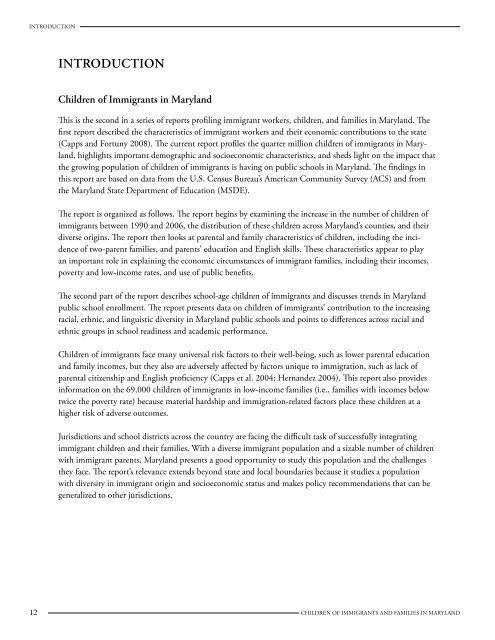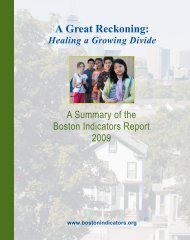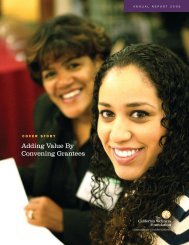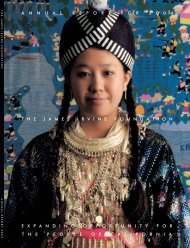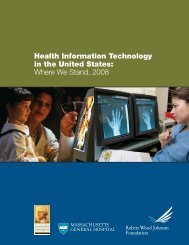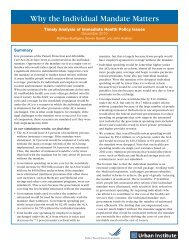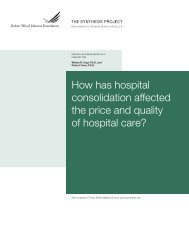The Integration of Immigrants and Their Families in Maryland: A ...
The Integration of Immigrants and Their Families in Maryland: A ...
The Integration of Immigrants and Their Families in Maryland: A ...
Create successful ePaper yourself
Turn your PDF publications into a flip-book with our unique Google optimized e-Paper software.
<strong>in</strong>troductionIntroductionChildren <strong>of</strong> <strong>Immigrants</strong> <strong>in</strong> Maryl<strong>and</strong>This is the second <strong>in</strong> a series <strong>of</strong> reports pr<strong>of</strong>il<strong>in</strong>g immigrant workers, children, <strong>and</strong> families <strong>in</strong> Maryl<strong>and</strong>. <strong>The</strong>first report described the characteristics <strong>of</strong> immigrant workers <strong>and</strong> their economic contributions to the state(Capps <strong>and</strong> Fortuny 2008). <strong>The</strong> current report pr<strong>of</strong>iles the quarter million children <strong>of</strong> immigrants <strong>in</strong> Maryl<strong>and</strong>,highlights important demographic <strong>and</strong> socioeconomic characteristics, <strong>and</strong> sheds light on the impact thatthe grow<strong>in</strong>g population <strong>of</strong> children <strong>of</strong> immigrants is hav<strong>in</strong>g on public schools <strong>in</strong> Maryl<strong>and</strong>. <strong>The</strong> f<strong>in</strong>d<strong>in</strong>gs <strong>in</strong>this report are based on data from the U.S. Census Bureau’s American Community Survey (ACS) <strong>and</strong> fromthe Maryl<strong>and</strong> State Department <strong>of</strong> Education (MSDE).<strong>The</strong> report is organized as follows. <strong>The</strong> report beg<strong>in</strong>s by exam<strong>in</strong><strong>in</strong>g the <strong>in</strong>crease <strong>in</strong> the number <strong>of</strong> children <strong>of</strong>immigrants between 1990 <strong>and</strong> 2006, the distribution <strong>of</strong> these children across Maryl<strong>and</strong>’s counties, <strong>and</strong> theirdiverse orig<strong>in</strong>s. <strong>The</strong> report then looks at parental <strong>and</strong> family characteristics <strong>of</strong> children, <strong>in</strong>clud<strong>in</strong>g the <strong>in</strong>cidence<strong>of</strong> two-parent families, <strong>and</strong> parents’ education <strong>and</strong> English skills. <strong>The</strong>se characteristics appear to playan important role <strong>in</strong> expla<strong>in</strong><strong>in</strong>g the economic circumstances <strong>of</strong> immigrant families, <strong>in</strong>clud<strong>in</strong>g their <strong>in</strong>comes,poverty <strong>and</strong> low-<strong>in</strong>come rates, <strong>and</strong> use <strong>of</strong> public benefits.<strong>The</strong> second part <strong>of</strong> the report describes school-age children <strong>of</strong> immigrants <strong>and</strong> discusses trends <strong>in</strong> Maryl<strong>and</strong>public school enrollment. <strong>The</strong> report presents data on children <strong>of</strong> immigrants’ contribution to the <strong>in</strong>creas<strong>in</strong>gracial, ethnic, <strong>and</strong> l<strong>in</strong>guistic diversity <strong>in</strong> Maryl<strong>and</strong> public schools <strong>and</strong> po<strong>in</strong>ts to differences across racial <strong>and</strong>ethnic groups <strong>in</strong> school read<strong>in</strong>ess <strong>and</strong> academic performance.Children <strong>of</strong> immigrants face many universal risk factors to their well-be<strong>in</strong>g, such as lower parental education<strong>and</strong> family <strong>in</strong>comes, but they also are adversely affected by factors unique to immigration, such as lack <strong>of</strong>parental citizenship <strong>and</strong> English pr<strong>of</strong>iciency (Capps et al. 2004; Hern<strong>and</strong>ez 2004). This report also provides<strong>in</strong>formation on the 69,000 children <strong>of</strong> immigrants <strong>in</strong> low-<strong>in</strong>come families (i.e., families with <strong>in</strong>comes belowtwice the poverty rate) because material hardship <strong>and</strong> immigration-related factors place these children at ahigher risk <strong>of</strong> adverse outcomes.Jurisdictions <strong>and</strong> school districts across the country are fac<strong>in</strong>g the difficult task <strong>of</strong> successfully <strong>in</strong>tegrat<strong>in</strong>gimmigrant children <strong>and</strong> their families. With a diverse immigrant population <strong>and</strong> a sizable number <strong>of</strong> childrenwith immigrant parents, Maryl<strong>and</strong> presents a good opportunity to study this population <strong>and</strong> the challengesthey face. <strong>The</strong> report’s relevance extends beyond state <strong>and</strong> local boundaries because it studies a populationwith diversity <strong>in</strong> immigrant orig<strong>in</strong> <strong>and</strong> socioeconomic status <strong>and</strong> makes policy recommendations that can begeneralized to other jurisdictions.12Children <strong>of</strong> <strong>Immigrants</strong> <strong>and</strong> <strong>Families</strong> <strong>in</strong> Maryl<strong>and</strong>


